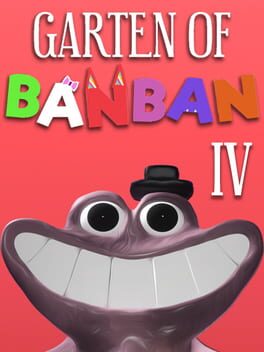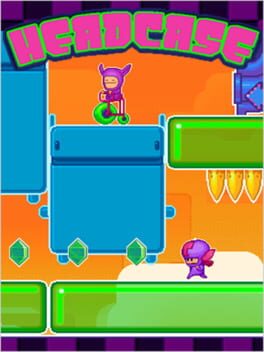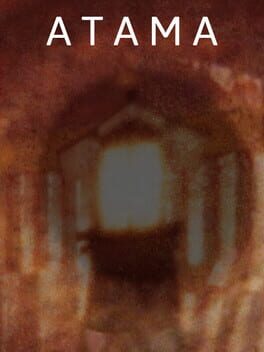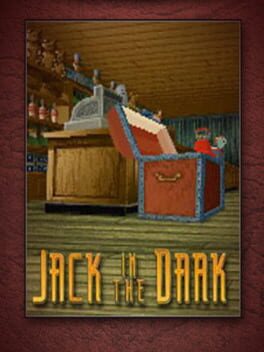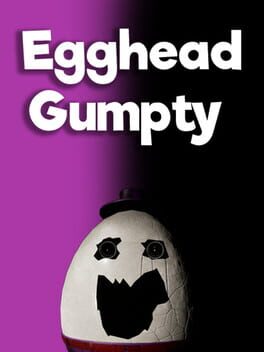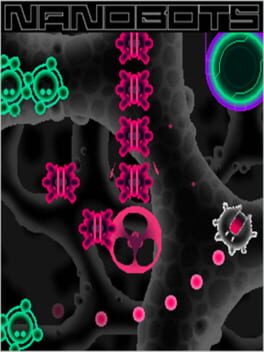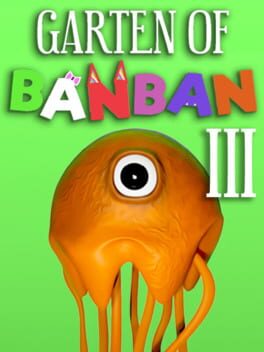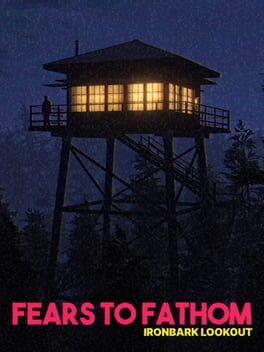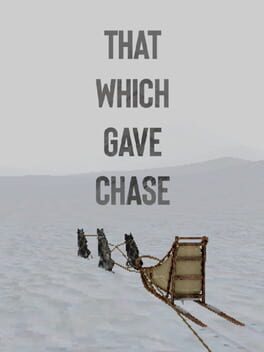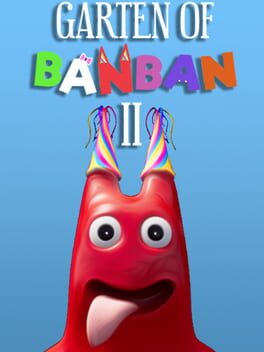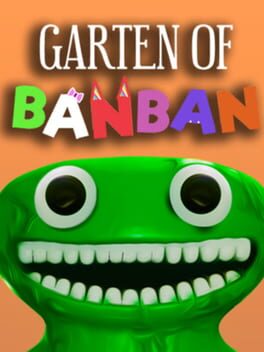radradradish
2023
Behold… a Euphoric Bros. game…. that’s actually kinda okay?
At least in comparison. A lot of the Garten of Banban hallmarks are still present. The game is dead-set onunsuccessfully trying to run over the two-hour refund threshold: in this case, padding the experience through looooong tram rides and sections where the player is forced to backtrack, each point of interest being a lengthy ways away from whatever other point of interest you’re currently at. When it’s not doing that, it’s not really doing anything interesting, either: the game never really takes advantage of its setting to do anything unique, instead just making you do clunky drone puzzles and then whatever fuck-you roadblock will make the game even longer as you figure out what you’re even meant to do. The game is utterly incapable, writing-wise, of a lot of what it’s actively trying to do: its scares don’t scare, its attempts at delivering its Deep Lore come off as both incomprehensible and not particularly interesting. Aesthetic-wise, the game puts its effort in all the wrong places. There’s so much needless detail on what are otherwise very simplistic models (which plays… weirdly with the lighting. everybody is so shiny), yet the way they move is so rigid and basic. There’s a moment where the… antagonist? of the chapter gives what’s ostensibly a Joker Rant on why he is the way he is, from which he… stands entirely still the whole time, just kinda staring at you through the window. Rids the moment of whatever impact it was meant to have. Just a little bit.
But even amongst all that there were moments which… if not necessarily showing promise, were still honestly enjoyable to go through. The game continues the upward trend Garten of Banban 3 did in having somewhat capable gameplay segments. No section stands out as egregiously bad, or anything that seems like it’s built to kill you as many times as possible to help get past the refund threshold. And even if what’s there… doesn’t really enhance the mood, or fit in with the general setting, some segments were honestly pretty fun. They finally have a puzzle utilizing the drone that I actually enjoyed going through, even if it’s still rather annoying to control. There’s this one segment where you have to memorize all the items in the rooms around you before then trying to figure out which of the rooms had something inside change and it was honestly super fun. Like, to the point where I wanted to try and do it again after I was done. There are some rough sections, and as a whole I’d say a lot of this feels… like going through the motions, trudging down the infinitely long hallways. Is it all that great? No, but for this series, it’s certainly an improvement.
Honestly, I also had a fun time watching things unfold, as well. Gone are most of the attempts to try and be funny — having a robot say the same three fandom in-jokes over and over again because apparently repetition is the best form of comedy — in favour of what mostly seems like a sincere attempt at being a serious Deep Lore horror game. And it’s like a soap opera. You never really know what’s going to happen next, be it something wild happening in the plot, some stupid gameplay concept you’re going to have to be stuck with for the next five minutes, some silly thing the game does to try and make its runtime as long as possible… it’s a wild ride, and something deeply, deeply entertaining, whether that’s despite itself or because of that. There’s also some stuff here I do like on its own merits. The new voice actors brought in by and large do a pretty decent job (and contrast rather amusingly with the DIY voice-acting of the older characters). There’s a couple jokes that stick the landing, and make me a bit more confident in the idea that there’s a little gift for… if maybe not anti-humour, being able to catch the player off guard in such a way as to bolster what’s happening. It’s clear, comparing this to its immediate predecessor (and also their other game Introvert: A Teenager Simulator actually) that they need to lean maybe a bit against their natural instincts to make their humour work, but I’m not being backhanded here: when it works, it does work.
So, like, given all that, I’d say I had fun with this in the end. I was thinking about maybe giving a bit more of a positive score, but ultimately the persistent feeling I had going through this was still a bit closer to antipathy than anything else. The game still wants to reach past the two-hour refund threshold without actually having enough content to get there, the core gameplay is kinda clunky and uninspiring, and on all fronts it kinda fails to be as effective as a horror experience as it wants to be. But on the other hand, after the genuinely kind of awful experience that was Garten of Banban 2... I definitely feel this series is on a bit of an upward tick. The gameplay is tolerable, and at points has some genuinely fun moments, and at the very least I think on the writing end the creators are leaning into the most entertaining parts of what they have here. Is it good? No. Passable? Maybe still not there, yet, but either way I had a good time. And I don’t necessarily think that’s the Stockholm Syndrome talking. 4/10.
At least in comparison. A lot of the Garten of Banban hallmarks are still present. The game is dead-set on
But even amongst all that there were moments which… if not necessarily showing promise, were still honestly enjoyable to go through. The game continues the upward trend Garten of Banban 3 did in having somewhat capable gameplay segments. No section stands out as egregiously bad, or anything that seems like it’s built to kill you as many times as possible to help get past the refund threshold. And even if what’s there… doesn’t really enhance the mood, or fit in with the general setting, some segments were honestly pretty fun. They finally have a puzzle utilizing the drone that I actually enjoyed going through, even if it’s still rather annoying to control. There’s this one segment where you have to memorize all the items in the rooms around you before then trying to figure out which of the rooms had something inside change and it was honestly super fun. Like, to the point where I wanted to try and do it again after I was done. There are some rough sections, and as a whole I’d say a lot of this feels… like going through the motions, trudging down the infinitely long hallways. Is it all that great? No, but for this series, it’s certainly an improvement.
Honestly, I also had a fun time watching things unfold, as well. Gone are most of the attempts to try and be funny — having a robot say the same three fandom in-jokes over and over again because apparently repetition is the best form of comedy — in favour of what mostly seems like a sincere attempt at being a serious Deep Lore horror game. And it’s like a soap opera. You never really know what’s going to happen next, be it something wild happening in the plot, some stupid gameplay concept you’re going to have to be stuck with for the next five minutes, some silly thing the game does to try and make its runtime as long as possible… it’s a wild ride, and something deeply, deeply entertaining, whether that’s despite itself or because of that. There’s also some stuff here I do like on its own merits. The new voice actors brought in by and large do a pretty decent job (and contrast rather amusingly with the DIY voice-acting of the older characters). There’s a couple jokes that stick the landing, and make me a bit more confident in the idea that there’s a little gift for… if maybe not anti-humour, being able to catch the player off guard in such a way as to bolster what’s happening. It’s clear, comparing this to its immediate predecessor (and also their other game Introvert: A Teenager Simulator actually) that they need to lean maybe a bit against their natural instincts to make their humour work, but I’m not being backhanded here: when it works, it does work.
So, like, given all that, I’d say I had fun with this in the end. I was thinking about maybe giving a bit more of a positive score, but ultimately the persistent feeling I had going through this was still a bit closer to antipathy than anything else. The game still wants to reach past the two-hour refund threshold without actually having enough content to get there, the core gameplay is kinda clunky and uninspiring, and on all fronts it kinda fails to be as effective as a horror experience as it wants to be. But on the other hand, after the genuinely kind of awful experience that was Garten of Banban 2... I definitely feel this series is on a bit of an upward tick. The gameplay is tolerable, and at points has some genuinely fun moments, and at the very least I think on the writing end the creators are leaning into the most entertaining parts of what they have here. Is it good? No. Passable? Maybe still not there, yet, but either way I had a good time. And I don’t necessarily think that’s the Stockholm Syndrome talking. 4/10.
2007
I feel like you could madlib reviews for some of these Nitrome games. In particular their 2D platformers: because they tend to suffer from the same strengths and pitfalls. The core strength here is in its central mechanic: pressing the action button to send you careening through the air (like a proto-VVVVVV) walking on the walls and ceilings to find your way through the level. It’s well-realized on its own, and the extra enemies and mechanics do well to vary your approach and provide some frenetic moments but Jesus what’s even the point of having health if over half the obstacles one hit kill you? What’s the point of finding pickups to restore it if you place them before it’s even possible to take damage? How am I meant to experiment and figure out what I need to do if I get instakilled within two seconds of reaching the next part of the level? Like, maybe if it just did damage and levels were a bit more of an endurance test I’d be able to live with it a little better, but it feels so fucking draining to get sent right back to the start despite being on full health, especially given how long individual levels get after a certain point. And I get that maybe I’m just repeating myself at this point but I feel like this is like, the fifth game with these exact problems. I certainly don’t regret doing this project — and even here it’s so fun to see just what exactly I remember playing these games when they were originally released — but at this point I could stand to play something a bit different. It's a bit clear that there's a consistent design ethos between all these different games.
2022
For what’s ostensibly a mashup between two different inspirations — the Siren series and Junji Ito’s The Hanging Balloons — it’s neat to see just how well the two blend together. Your goal is to find an old family heirloom in an abandoned village, pursued by beings known as ‘The Ascended’: the former denizens who have since become hot-air-balloon-like creatures, capable of flying high above the ground, with the aim of swooping in and killing you on sight. Your only recourse against them is to use your family’s ancestral ability to enter the senses of those around you, seeing what the Ascended see, figuring out where they are, and using that to escape their notice as you delve deeper and deeper into the village. I love how varied the level design is: you never do the same thing twice. You can go from having to sneak across a large swathe of the town, to having to solve a puzzle to get rid of the enemies guarding where you need to go, to then having to open and close doors to bait and trap enemies and clear a path through. Even when the game goes back to ‘sneak through this gauntlet’ there’s generally some twist to keep it fresh: maybe you have to climb up rather than go across, maybe you have to sneak through a maze, maybe you have something that can help you navigate through all the enemies. The game consistently keeps itself fresh, and even if some sections are more memorable than others it never wears out its welcome, doing a very effective job at building up right until the end.
I… do wish the sensejacking mechanics were a bit more viable? A lot of the time when I tried to use it I found myself trying to figure out which enemy I was even in the head of — and, conversely, which specific enemy was the one I needed to sensejack — and while there are sometimes context clues to help figure it out, the environmental design is maybe a bit too samey for you to immediately tell if you’re in the head of the enemy you’re looking for, compounded by how long scrolling through the list can generally take. Maaaaaaaakes some areas a bit rough to go through, and a lot of the time made just trying to improvise and stealth more viable than using sensejacking to plan ahead. Aside from that, though, this was super cool: I love the core mechanic and how the game toys with it the further and further you go through, and I’m also a fan of a lot of the little visual design quirks — how your sensejacking is represented, how you can see the gunk inside the necks of the Ascended — and even if maybe I wish the core mechanic was a little less disorientating it still does a lot of cool (and creepy) shit with it. Definitely recommend this, and I’m really hoping to see more cool stuff from this dev in the future.
I… do wish the sensejacking mechanics were a bit more viable? A lot of the time when I tried to use it I found myself trying to figure out which enemy I was even in the head of — and, conversely, which specific enemy was the one I needed to sensejack — and while there are sometimes context clues to help figure it out, the environmental design is maybe a bit too samey for you to immediately tell if you’re in the head of the enemy you’re looking for, compounded by how long scrolling through the list can generally take. Maaaaaaaakes some areas a bit rough to go through, and a lot of the time made just trying to improvise and stealth more viable than using sensejacking to plan ahead. Aside from that, though, this was super cool: I love the core mechanic and how the game toys with it the further and further you go through, and I’m also a fan of a lot of the little visual design quirks — how your sensejacking is represented, how you can see the gunk inside the necks of the Ascended — and even if maybe I wish the core mechanic was a little less disorientating it still does a lot of cool (and creepy) shit with it. Definitely recommend this, and I’m really hoping to see more cool stuff from this dev in the future.
1993
As a promotional game, meant more to show what Alone in the Dark 2 could offer rather than stand as its own experience, Jack in the Dark, on the surface, seems quite limited. With only one room to walk around, and a handful of puzzles to solve, the whole thing can be completed in ~ten minutes, but even regardless of that there’s a good amount on offer here. The setting of the toy shop is fairly aesthetically pleasing and well-utilized — all the puzzles lean into the setting of the store, near-exclusively using object and enemy models that weren’t otherwise recycled for Alone in the Dark 2. The fixed camera does well to capture some rather clever and cool-looking angles without ever getting in the way or accidentally hiding anything from the player. The rather goofy tone manages to come across even with the little runtime it has, the enemy (and player!) animations being rather charming as they plod across the room and the plot going into… what’s ostensibly a rather off-the-wall direction with an entirely straight face. The limits of this being a tech demo, in a way, become a strength: the game can focus purely on the things it's best at, and strip back most of the systems and complexity that otherwise… have historically held more full-length Alone in the Darks back. Maybe a shame that this is as simple as it is — I would’ve loved to see something like one of Alone in the Dark 2’s stealth sections in here — but I can’t deny that it does basically everything it wants to. It gets into the action, shows off what Alone in the Dark 2’s engine is capable of, and does enough to stand out a little on its own merits, too. Frankly, the fact that I’m left wanting more is a good thing here. Would've loved to have seen this expanded on.
2007
This was my Sonic as a kid. And honestly, playing it today, the comparison feels rather akin to my impression of what the 2D Sonic games are like. You control a cable car, tasked with driving it through the level, avoiding the obstacles along the way, and what’s most important is your momentum: you can go fast, of course, but that’ll often just lead you to crash directly into something, or lose control and flip over. You can take it slow… but oftentimes you’ll need to hit something at a certain speed to get past it. It becomes a matter of knowing what’s coming ahead and knowing what speed you want to hit it at, and, as you begin to get more familiar with the level, refining your movement over and over again until you can attain the most optimal path through the level. It’s a fun loop, and levels are generally short enough that it’s loosely addicting to try, try again at each death until you eventually get the winning run. And once again Nitrome does an excellent job at mixing and matching all their different elements to make each level feel distinct from the other: even something as simple as moving left through the entire level brings so many things you have to learn and consider. I’m maybe not as into how little you get to see ahead of yourself — sometimes you won’t be able to do a section first try because you straight up won’t see it coming until you’re past the point where you can reorient/change your speed. The last level, too, is also… a rather lame way to finish the game off, supplanting what was a pretty inventive and challenging and fun climax with something much lamer, demanding a kind of ridiculous precision and not even having the courtesy to end right after the level’s most difficult point, forcing you to have to do it over and over again just to have a chance at doing the rest of the level. It… kinda sucks, and maybe eclipsed the rest of the game enough to derail my feelings about the experience as a whole but barring that this is a recommendation. It’s cute, it’s got a neat core mechanic, and it bends and tests your mastery of it in a way that really scratches that difficult game itch. Maybe not Nitrome firing on all cylinders... but it sure gets pretty close.
2022
I didn’t know it was possible for one game to ape from this many different eras of indie horror. Egghead Gumpty has it all: from the page key collecting gameplay of Slender: The Eight Pages, the jumpscares on-fail (which make you stop in your tracks half a second before they happen so they’ll never take you off guard) a la Five Nights at Freddy’s, and a procedurally generated setting that totally isn’t The Backrooms you guys, it’s clear that this game is a patchwork chimera of much more trendsetty horror games, and one that… is certainly not the sum of its parts. Even what here that’s original isn’t exactly functional: the titular Egghead Gumpty’s main mechanic is that he’ll appear somewhere in the room you’re in, and you’ll have to find him before a timer runs out, which works when it happens when you’re in a room, but when you’re in any of the corridors — which are all rather long and undefined in shape given the procedural generation — he can spawn far enough away from you that you have no clue where he is and can’t really get an inkling of his location before he kills you. There’s this baby thing that… I think you’re meant to play Red Light Green Light with, but the mechanics around it are so unclear and I died every time I dared to try figure it out. The procedural generation, I feel, does more harm and good here: even other than RNG bullshit where you lose resources/can’t find the places you need to go I feel like it’s hard to feel invested into figuring out your surroundings and figuring out the optimal way to collect everything when the floors change every time you die or even when the floors sometime delete themselves and trap you inside a dead end. I tried this for about 90 minutes, sometimes making some progress before getting fucked over by the puppet baby or Gumpty making me find him in one of the huge hallways. Maybe if I put in some effort I could complete it… but also I didn’t really feel much of a need to. I feel like faffing about and getting killed for 90 minutes really got me to the yolk of the experience here.
To reiterate from when I first reviewed this: I’m no fan of ‘parody’ visual novels — and how they tend to gobble up media attention from brethren that are aiming for something beyond ‘haha, it’s meant to be bad!’ cynicism — but this sticks the landing. For a couple of reasons: even beyond the fairly solid production values, even beyond how regardless of the ‘dating sim the Old Gods!’ veneer it's a fairly solid adaptation of the mythos and characters it's drawing off, what it does best is how beyond the visual novel elements it plays more like an adventure game than anything else. A pretty solid one, too. Rather than making choices or picking dialogue, progress is gated primarily by the things you do in gameplay: mixing and matching all the different things in your apartment to perform all the different rituals, as well as taking in context clues to figure out the order of operations for certain endings. It’s fun to play, a… not terrible lead-in to cosmic horror for those unacquainted with it (and having some cute references for anyone who does have that innate familiarity)... but maybe, perhaps, doesn’t feel as polished as it could be. The UI tends to get in its own way: accidentally grabbing items when you meant to move the screen around, closing the ritual book when you're trying to speak an incantation. There are… enough typos for me to notice it as a consistent problem, to the point where this really would have benefitted from an edit pass. I like the final section a good bit — how genuinely stressful it manages to feel for a game that’s been pretty light on difficulty beforehand — but it goes on for way too long and sends you all the way back for failure, not helped by how finicky it feels to drag your mouse across the screen and speak out spells. It doesn’t dilute too hard from the core of the gameplay, and it manages to theme itself around its cosmic horror influences in a way that thankfully doesn’t feel like it’s just going ‘haha… what if there was a dating sim where you kissed Cthulhu???’, I just think maybe that there are certain things here that stop it from being great rather than good, and that a bit more time spent on certain aspects of the game could’ve done a lot to bridge that particular gap.
2007
nitrome games if their marathon-length levels didn’t send you right back to the start when you died
Nanobots is a bullet-hell shoot ‘em up mostly reminiscent of Ikaruga in how, to damage enemies, you must change the colour of your little ship to match them. There are a couple core differences, though. First is that, rather than the traditional vertical screen, you’re allowed to freely roam a circular arena, kind of like what I understand of Geometry Wars. Second is that, rather than being able to change at will, you must traverse to certain parts of the arena to switch colour: for which the weapon you’re using will also change. It’s fun to move around the stage demolishing the scores of enemies that enter the arena, decently frenetic when you’re low on health and you need to survive long enough for the level to end/health packs to spawn in, and I love how your weapons upgrade and become capable of more as the game goes on, and how this is paired against the steadily increasing threat and numbers of enemies. On paper, it’s fun, but… God do levels being so overtly long kill it. Perhaps if there were checkpoints, or if the levels were split a bit more, or if there was a way to speed it up to get to the part where you died quicker, it’d be fine, but as is getting killed can be as easy as being on top of an enemy when it spawns, or hitting an obstacle that’s bugged and only has its hitbox show up, and can take you back as much as five minutes every time. It’s draiiinnning, and the fact that health packs disappear if you don’t pick them up turns what are otherwise fun levels into total endurance tests, enough so that I genuinely considered quitting even on the earliest levels. I’m glad I didn’t, because ultimately I do think I had fun in the end, but as far as Nitrome games I’d recommend… maybe not this one. At least not unless you've got some free time and patience on you. It can be rouuuuuuugh.
Nanobots is a bullet-hell shoot ‘em up mostly reminiscent of Ikaruga in how, to damage enemies, you must change the colour of your little ship to match them. There are a couple core differences, though. First is that, rather than the traditional vertical screen, you’re allowed to freely roam a circular arena, kind of like what I understand of Geometry Wars. Second is that, rather than being able to change at will, you must traverse to certain parts of the arena to switch colour: for which the weapon you’re using will also change. It’s fun to move around the stage demolishing the scores of enemies that enter the arena, decently frenetic when you’re low on health and you need to survive long enough for the level to end/health packs to spawn in, and I love how your weapons upgrade and become capable of more as the game goes on, and how this is paired against the steadily increasing threat and numbers of enemies. On paper, it’s fun, but… God do levels being so overtly long kill it. Perhaps if there were checkpoints, or if the levels were split a bit more, or if there was a way to speed it up to get to the part where you died quicker, it’d be fine, but as is getting killed can be as easy as being on top of an enemy when it spawns, or hitting an obstacle that’s bugged and only has its hitbox show up, and can take you back as much as five minutes every time. It’s draiiinnning, and the fact that health packs disappear if you don’t pick them up turns what are otherwise fun levels into total endurance tests, enough so that I genuinely considered quitting even on the earliest levels. I’m glad I didn’t, because ultimately I do think I had fun in the end, but as far as Nitrome games I’d recommend… maybe not this one. At least not unless you've got some free time and patience on you. It can be rouuuuuuugh.
2023
When I covered Squirrel Stapler in its original form, I noted that the updated version at least seemed like it was taking steps in the right direction, working on deepening what was already there as opposed to expanding the (already rather long) length of the original. What I didn’t quite realize was that that was a joke: the “expanded mechanics” talked about are random stalls plonked around the forest that at best, only superficially add to the game, poking fun at how some game rereleases tend to add things that futz with the original game to justify their own existence — kind of like The Stanley Parable: Ultra Deluxe in that regard. What the rerelease does do, however, is make the game feel much more friendly to play: the forest is a lot more populated so you don’t have to scour the landscape for several minutes just trying to find (and then go through the whole process of sneaking up on) a single squirrel, and there seem to be fewer enemies, keeping death as a setback but also making it much less frequent as it sometimes got in the original. It doesn't quite fix what I felt to be the biggest problem with the original version: days 3-5 still feel like the same loop three times without much added in between. At the very least, though, the quality of life changes make it much easier to deal with, and helps the game lean in on its strengths: the way the narrative builds up, the way the game simplifies/parodies the mechanics of a hunting simulator while still managing to emulate the general feel, and how the game (like others from its creator) builds up this absolutely bizarre premise around the player yet makes it feel like the most normal thing in the world. They’re perhaps not the iterations I maybe wanted to see going in (and I do wish day 4, in particular, didn't feel like the game was repeating itself), but they are improvements, and as a whole I’d recommend this as the definitive Squirrel Stapler. I got to see God this time :).
2023
Garten of Banban 3 is the best Garten of Banban so far. Whether that speaks to actual quality, or merely just being the tallest dwarf… okay, definitely the latter, but it at least made me question that to myself for a couple of minutes, and that says something. And not just about how it’s easy to overrate things when they exceed your expectations. The game is actually playable: unlike the previous games, all I had to do were to change some of the settings on PC and it ran fine the whole way through, and to be honest I probably could’ve gotten away with having them on high if it weren’t for me being paranoid that something was going to be all fucked up later. Many of the sections you go through feel improved as well: they’re not just killboxes that seek to make you reload as many times as possible, they’re attempts at setpieces. They’re clear, distinct moments with puzzles that, at times, can be loosely fun/satisfying to try and solve. The game’s also fairly decent at evoking stress — making the player fret as they try and solve the current section, making them dread what’s coming up — even if… it’s perhaps not quite in the way that was initially intended.
Because, while it’s certainly better than its predecessors, that still doesn’t mean it’s anything approaching good. The mission statement of this game, like Garten of Banban II, is still to stall for time in hopes of getting over the Steam refund threshold, it’s just that the developers are far more benign about it this time. Honestly it’s kind of funny to see just how blatant they are about it: the long pauses between lines of dialogue, the stretched-out gondola rides between each of the major areas, the way the game will try and randomly hide things like switches or items from plain sight, or how there are points where the game makes you jump off a surface to grab an item or hit a switch and you have to wrestle against the game to be able to actually hit it, it’s loosely a marvel to see how the game will stretch itself out next. There’s this one corridor where you have to open, like, eight doors in a row before you actually reach the next room. There’s another part directly copy/pasted from Garten of Banban II. I think my personal favourite is when the game tells you that the guy you’re looking for is on another part of the floor, but that there’s a BAD GUY on the same part of the floor you’re on and that you’re going to need to deal with him if you want to leave… only for you to immediately be told to leave and go to a different section of the floor in order to deal with him. It’s clear that these are all just excuses to extend the length of the game. And it’s also clear that the chops aren’t there to create an internal justification for any of itself, or to stitch together all these disparate sections into a coherent whole. But at the very least it’s much more friendly than II’s reliance on cheap deaths and extremely lengthy runs between checkpoints (even if there were sections that veered wayyyyyyyyyyyy longer than felt necessary or fun), and while there’s not quite a narrative structure, the way the map splits itself off into four distinct sections at the very least gives the player an indication of how far they are through the game, and, for better or worse, how close they are to the end.
I mentioned in my review for II that I did have loose hopes this game would be an improvement, based on what seemed like a capacity for humour combined with an inclination that the game started getting a bit more in on the joke from this point onward. Tragically, I was wrong on that: while there is inherent value in the voice acting, the limp attempts at jumpscares, and just how blatantly the game pads itself out, its attempts at actively leaning into this fall rather flat. Primarily because it manifests in spouting fanbase in-jokes far past the point where it initially could’ve been cute. In particular, the game loves to have Banban mention eating pancreases — a reference to the first game, where the game attempts to have its seemingly friendly aesthetics turn sinister by having a mural say “sharing is caring! Your pancreas is mine!” It was ridiculed, so the devs tried to do it ironically, but in the kind of way that mostly just kills the joke: especially when there’s a robot you have to push that spouts off a line about pancreases and another in-joke like ten times in as many seconds. The humour also veers… a bit long for its own good: the oft-mentioned car scene manages to hit some loosely absurdist beats before it… keeps going without much new material, only choosing to end about double the length it probably should’ve been. There’s one minor beat I thought was cute — a moment where the game tries to sandbag you in a way that’s honestly rather charming — but as a whole… man if this is the developer’s way of leaning in on the joke and trying to laugh with the people playing the game… I can’t really say I’m looking forward to that aspect anymore. I’m rather disappointed, honestly.
And overall… okay, yeah, it’s certainly an improvement, and maybe that, for a second, confused my brain into thinking “wait, is this really that bad? I don’t hate it, honestly,” but having gone through the whole thing, and having a couple of hours to put it all into perspective… it might be the least bad, but that doesn't make it any less bad. While it’s perhaps this series at its most playable, so far, it’s now gained an additional problem in that while its attempts at crafting a serious horror experience are ineffective as to cross the line into comedy, its newfound attempt at leaning into that comedic aspect falls far, far from the point where it could’ve worked. Given that I’m probably at this point committed to going through the rest of the series, though, I’ll at least take my blessings where I can find them: if this is the bar, the general structure, the way it’s going to pad itself out going forward, then I can’t imagine I’m gonna have that bad a time going forward. 3/10.
Because, while it’s certainly better than its predecessors, that still doesn’t mean it’s anything approaching good. The mission statement of this game, like Garten of Banban II, is still to stall for time in hopes of getting over the Steam refund threshold, it’s just that the developers are far more benign about it this time. Honestly it’s kind of funny to see just how blatant they are about it: the long pauses between lines of dialogue, the stretched-out gondola rides between each of the major areas, the way the game will try and randomly hide things like switches or items from plain sight, or how there are points where the game makes you jump off a surface to grab an item or hit a switch and you have to wrestle against the game to be able to actually hit it, it’s loosely a marvel to see how the game will stretch itself out next. There’s this one corridor where you have to open, like, eight doors in a row before you actually reach the next room. There’s another part directly copy/pasted from Garten of Banban II. I think my personal favourite is when the game tells you that the guy you’re looking for is on another part of the floor, but that there’s a BAD GUY on the same part of the floor you’re on and that you’re going to need to deal with him if you want to leave… only for you to immediately be told to leave and go to a different section of the floor in order to deal with him. It’s clear that these are all just excuses to extend the length of the game. And it’s also clear that the chops aren’t there to create an internal justification for any of itself, or to stitch together all these disparate sections into a coherent whole. But at the very least it’s much more friendly than II’s reliance on cheap deaths and extremely lengthy runs between checkpoints (even if there were sections that veered wayyyyyyyyyyyy longer than felt necessary or fun), and while there’s not quite a narrative structure, the way the map splits itself off into four distinct sections at the very least gives the player an indication of how far they are through the game, and, for better or worse, how close they are to the end.
I mentioned in my review for II that I did have loose hopes this game would be an improvement, based on what seemed like a capacity for humour combined with an inclination that the game started getting a bit more in on the joke from this point onward. Tragically, I was wrong on that: while there is inherent value in the voice acting, the limp attempts at jumpscares, and just how blatantly the game pads itself out, its attempts at actively leaning into this fall rather flat. Primarily because it manifests in spouting fanbase in-jokes far past the point where it initially could’ve been cute. In particular, the game loves to have Banban mention eating pancreases — a reference to the first game, where the game attempts to have its seemingly friendly aesthetics turn sinister by having a mural say “sharing is caring! Your pancreas is mine!” It was ridiculed, so the devs tried to do it ironically, but in the kind of way that mostly just kills the joke: especially when there’s a robot you have to push that spouts off a line about pancreases and another in-joke like ten times in as many seconds. The humour also veers… a bit long for its own good: the oft-mentioned car scene manages to hit some loosely absurdist beats before it… keeps going without much new material, only choosing to end about double the length it probably should’ve been. There’s one minor beat I thought was cute — a moment where the game tries to sandbag you in a way that’s honestly rather charming — but as a whole… man if this is the developer’s way of leaning in on the joke and trying to laugh with the people playing the game… I can’t really say I’m looking forward to that aspect anymore. I’m rather disappointed, honestly.
And overall… okay, yeah, it’s certainly an improvement, and maybe that, for a second, confused my brain into thinking “wait, is this really that bad? I don’t hate it, honestly,” but having gone through the whole thing, and having a couple of hours to put it all into perspective… it might be the least bad, but that doesn't make it any less bad. While it’s perhaps this series at its most playable, so far, it’s now gained an additional problem in that while its attempts at crafting a serious horror experience are ineffective as to cross the line into comedy, its newfound attempt at leaning into that comedic aspect falls far, far from the point where it could’ve worked. Given that I’m probably at this point committed to going through the rest of the series, though, I’ll at least take my blessings where I can find them: if this is the bar, the general structure, the way it’s going to pad itself out going forward, then I can’t imagine I’m gonna have that bad a time going forward. 3/10.
Fears to Fathom: Ironbark Lookout asks an important question: what if public bathrooms didn’t have any toilets? What if there was instead a room where everybody has to piss on the floor?
…Playing this game before there were any patches was maybe not the greatest idea. In addition to the restaurant piss room mentioned above (where the toilet I was meant to pee in did not have a visible model), my playthrough was fairly marred by glitches and other technical issues. On the default graphics settings the game can’t handle itself: things slow to a crawl, and there’s this motion blur when looking around which is rather sickening to have to deal with. Setting them lower doesn’t help, either: all it does is make the lighting so bright as to be painful, and the game still didn’t seem to be capable of handling its rather expansive areas. Not to mention the glitches: how I got softlocked at one point because my attempt to put down something it turned out I’d later need clipped through the floor and out of bounds, and how you’re not fast enough to be able to clear the final chase… unless you move diagonally, zigzagging somehow being faster than just… running normally. I was excited to play this game upon its release — as I’d really liked the previous games in the series and wanted to go into one of them blind — but I think, maybe, I needed to wait a bit longer, because the issues that hadn’t been patched out yet were enough to effect my overall enjoyment of the game.
Which is a bit of a shame, because otherwise I liked a lot of what this game had to offer. What this series in particular excels at is managing to capture how it feels to be where you are: both the natural horror that can come out of the situation you’re in… and also the serene, the pretty, the parts that… almost feel like home. Namely, I’m struck by the picture it captures of national park life: all the routines you have to go through each night, all the times you have to upend everything because somebody in the park did something they’re not supposed to, becoming friends with a disembodied voice on the radio, and how you slowly make your assigned firetower yours: opening and closing the shutters each night, throwing all your shitthrough the floor across the place, and slowly getting a familiarity of the space around you as the days go by. It’s a surprisingly comfy game, even as things start building up around you, and frankly it made me wonder if I’d personally be into the park ranger life. It plays well with the horror aspects, as the intrusions on your idyllic park ranger life turn from normal to absolutely not, and even if… I do have some questions about whether this really is a true story somebody sent in, I can’t deny that it otherwise works. Even if I should’ve waited before I otherwise experienced it for myself. 8/10.
…Playing this game before there were any patches was maybe not the greatest idea. In addition to the restaurant piss room mentioned above (where the toilet I was meant to pee in did not have a visible model), my playthrough was fairly marred by glitches and other technical issues. On the default graphics settings the game can’t handle itself: things slow to a crawl, and there’s this motion blur when looking around which is rather sickening to have to deal with. Setting them lower doesn’t help, either: all it does is make the lighting so bright as to be painful, and the game still didn’t seem to be capable of handling its rather expansive areas. Not to mention the glitches: how I got softlocked at one point because my attempt to put down something it turned out I’d later need clipped through the floor and out of bounds, and how you’re not fast enough to be able to clear the final chase… unless you move diagonally, zigzagging somehow being faster than just… running normally. I was excited to play this game upon its release — as I’d really liked the previous games in the series and wanted to go into one of them blind — but I think, maybe, I needed to wait a bit longer, because the issues that hadn’t been patched out yet were enough to effect my overall enjoyment of the game.
Which is a bit of a shame, because otherwise I liked a lot of what this game had to offer. What this series in particular excels at is managing to capture how it feels to be where you are: both the natural horror that can come out of the situation you’re in… and also the serene, the pretty, the parts that… almost feel like home. Namely, I’m struck by the picture it captures of national park life: all the routines you have to go through each night, all the times you have to upend everything because somebody in the park did something they’re not supposed to, becoming friends with a disembodied voice on the radio, and how you slowly make your assigned firetower yours: opening and closing the shutters each night, throwing all your shit
Novel, interesting… goes on roughly twice the length it should. When I started playing I was rather quickly impressed by how the sled dog gameplay made movement feel: the deliberate finickiness of the anchor whenever you wanted to stop and start, how important it is to lean your character in a particular direction to prevent the sled from tipping over. I also love how expansive the areas you go through are, and not only how easy it is to get lost, but how easy it is to find your way again, the poles all over the arctic wilderness installing a sense of familiarity and direction and allowing you to make it to your destination from anywhere. I liked the way the story was presented: how quickly you cue into its non-linear nature, how you start to piece things together, how the mystery builds up to what feels like a major reveal… and then the game keeps going for 30 more minutes. You’re put into new section after new section, each one feeling like ‘okay, the game has to end here, right?’ and then it keeps on going. And it never really feels like you actually get anything out of these segments, no extra context, nothing you haven’t already learned. Maybe if there was more added to the plot, or maybe if the reveals felt staggered throughout the game rather than the last one being about halfway through, it could’ve ran its runtime better, but as is it feels like it peaks early and then it’s just going through the motions from that point on. Willing to give this game a bit of the benefit of the doubt given that I played it right after another game put me in a rather foul mood, but I think even if that hadn’t happened I would’ve had the same takeaway: neat idea, executed well, but also this does not have the runtime to fill an hour. 6/10.
2023
When I played the first Garten of Banban, I found it… not particularly worth the ire. Was it good? Not particularly, but its faults — and its shameless attempts to copy Poppy Playtime — were more funny to me than anything, and not quite capable of manifesting any particular hatred. It’s short, it’s mostly whatever, and the only role it has to play in the commercialization of ‘mascot horror’ is merely just being the most blatant about it. The idea that it (at the time of writing) is considered the 10th 11th worst game of all time, more than anything, is a sign that maybe people need to play more bad games, and that bandwagons can easily catapult something far past wherever it otherwise should be. I can understand feeling that Garten of Banban is a 1/10 because it has nothing to offer — frankly, that’s where I should probably put it. I’m much more confused at the idea that it’s a game that inspires frothing hatred, worth being considered the death of an entire genre, worth the harassment of the devs off social media. There’s just not enough there to really inspire anything passionate.
Garten of Banban II, on the other hand…
…exists solely, blatantly, to waste your time. There’s a throughline, sure — you go down deeper into the depths of the facility, you get your first glimpses of the Deep Lore as the real horror begins — but it's not nearly enough to sustain the full length of the game. Tragically, however, Steam’s refund settings allow people to buy a game, beat it, and then get their money back if they can do it in two hours. The devs didn’t want that to happen to them, so they padded the game out as much as they could to try and prevent that. Which: I don’t blame them, there’s been some history of indie developers not making back their budgets for otherwise well-received games because of people abusing the Steam refund system, I fully understand wanting to avoid that same thing yourself. I feel like there are much smoother ways of achieving this goal without compromising the quality of your work, especially if you’re releasing your game episodically, but I guess, in lieu of any better ideas, this idea works as well as any.
But god does that make this painful to play. The game does everything to make sure that runtime goes over the two-hour mark. Part of this is by natural padding: adding sections that mean nothing, that contribute nothing to the story, that make the whole thing disjointed and kind of aimless. Maybe there’s a concrete beginning, middle, and end in there somewhere, but it’s like an anime with constant, pervasive filler: so much content for the sake of stalling for time that it dilutes and gets in the way of whatever it is that actually moves things forward. It’s not good content, either. It’s clunky, it’s unclear (you’ll have no idea how you’re meant to interact with puzzle elements even if you know, step by step, what you’re meant to do), and it’s not particularly fair. Which is how it pads the runtime out, partially, since your autosaved checkpoints will send you far back before the point where you actually died. Fail the comically long first-person platformer segment (which has no relevance to the greater anything) because this game wasn’t built to be a platformer? Do it all over again. Get killed by the giant bird in a situation that still doesn’t take advantage of its theoretically interesting bird-of-prey AI? Sorry, you gotta collect all the babies again, and the controls for it aren’t any better this time than it was the first time. Fail the classroom segment because it’s all trial and error where one mistake is instant death? Hope you don’t mind not being able to skip the dialogue. It’s so genuinely frustrating. And so much more so when it’s so evident there’s no greater purpose beyond using up more of your time.
It runs like shit, too. Like, generally I’m not someone who super cares about PC performance stuff — if something lags or has graphical hiccups that’s more on me for playing it on PC — but that’s for, like, high-end stuff. Not Garten of Banban. Why is there so much motion blur? Why can’t I turn it off? Why is the framerate so bad as to be actually sickening to look at? Initially I shrugged and just turned everything down… but it still lagged, and now everything was so dark and low saturation that it’s impossible to see the things you need to interact with. A solid tenth of the game was literally me futzing with the graphics settings to see if I could stop it from chugging, and this is on a decently high-end gaming laptop, so preeeeetty sure it’s not my fault, there. It’s not even just an issue of “the game is normal but laggy,” certain sections are so much harder because they don’t run well. If you turn the lighting down too low (and you have to if you want it to run) you legitimately can't see anything: the buttons you need to press to open a door, the specific corridors you need to go down during a chase scene. There’s this part where you have to grab a bunch of baby birds and put them in a nest, but also the lag makes it so hard to catch them, both because they weave and turn in a way that makes it so genuinely hard to corner them and also because the lag makes it hard to tell if you’ve caught one: so many times I caught then immediately let them go. It was painful. The whole game was painful.
…It’s still not a 1/10, though, and this time, it’s because there’s a little bit of merit in the writing. Not necessarily the plot, or the lore — I didn’t care about those — but… there’s a little penchant for what feels like anti-humour that genuinely, almost made me smile a little bit. The whole section in the classroom, gameplay issues aside, was genuinely kind of funny, whether for the intended reason or not. “It’s okay to have no friends and be miserable like me!” is a quote that has genuinely stuck in my head at least once every couple days since playing this. It doesn’t save the game, even remotely — it plays like shit and it runs like shit all just to try and get past Steam’s refund thresholds — but, having heard that episodes three and onward start to lean into the joke a bit more… I have decent faith, given what works here, that maybe I’ll have a bit more fun when I eventually yeet myself back into the mines. Just not right now. Because going through this put me in a bad, bad mood. 2/10.
Garten of Banban II, on the other hand…
…exists solely, blatantly, to waste your time. There’s a throughline, sure — you go down deeper into the depths of the facility, you get your first glimpses of the Deep Lore as the real horror begins — but it's not nearly enough to sustain the full length of the game. Tragically, however, Steam’s refund settings allow people to buy a game, beat it, and then get their money back if they can do it in two hours. The devs didn’t want that to happen to them, so they padded the game out as much as they could to try and prevent that. Which: I don’t blame them, there’s been some history of indie developers not making back their budgets for otherwise well-received games because of people abusing the Steam refund system, I fully understand wanting to avoid that same thing yourself. I feel like there are much smoother ways of achieving this goal without compromising the quality of your work, especially if you’re releasing your game episodically, but I guess, in lieu of any better ideas, this idea works as well as any.
But god does that make this painful to play. The game does everything to make sure that runtime goes over the two-hour mark. Part of this is by natural padding: adding sections that mean nothing, that contribute nothing to the story, that make the whole thing disjointed and kind of aimless. Maybe there’s a concrete beginning, middle, and end in there somewhere, but it’s like an anime with constant, pervasive filler: so much content for the sake of stalling for time that it dilutes and gets in the way of whatever it is that actually moves things forward. It’s not good content, either. It’s clunky, it’s unclear (you’ll have no idea how you’re meant to interact with puzzle elements even if you know, step by step, what you’re meant to do), and it’s not particularly fair. Which is how it pads the runtime out, partially, since your autosaved checkpoints will send you far back before the point where you actually died. Fail the comically long first-person platformer segment (which has no relevance to the greater anything) because this game wasn’t built to be a platformer? Do it all over again. Get killed by the giant bird in a situation that still doesn’t take advantage of its theoretically interesting bird-of-prey AI? Sorry, you gotta collect all the babies again, and the controls for it aren’t any better this time than it was the first time. Fail the classroom segment because it’s all trial and error where one mistake is instant death? Hope you don’t mind not being able to skip the dialogue. It’s so genuinely frustrating. And so much more so when it’s so evident there’s no greater purpose beyond using up more of your time.
It runs like shit, too. Like, generally I’m not someone who super cares about PC performance stuff — if something lags or has graphical hiccups that’s more on me for playing it on PC — but that’s for, like, high-end stuff. Not Garten of Banban. Why is there so much motion blur? Why can’t I turn it off? Why is the framerate so bad as to be actually sickening to look at? Initially I shrugged and just turned everything down… but it still lagged, and now everything was so dark and low saturation that it’s impossible to see the things you need to interact with. A solid tenth of the game was literally me futzing with the graphics settings to see if I could stop it from chugging, and this is on a decently high-end gaming laptop, so preeeeetty sure it’s not my fault, there. It’s not even just an issue of “the game is normal but laggy,” certain sections are so much harder because they don’t run well. If you turn the lighting down too low (and you have to if you want it to run) you legitimately can't see anything: the buttons you need to press to open a door, the specific corridors you need to go down during a chase scene. There’s this part where you have to grab a bunch of baby birds and put them in a nest, but also the lag makes it so hard to catch them, both because they weave and turn in a way that makes it so genuinely hard to corner them and also because the lag makes it hard to tell if you’ve caught one: so many times I caught then immediately let them go. It was painful. The whole game was painful.
…It’s still not a 1/10, though, and this time, it’s because there’s a little bit of merit in the writing. Not necessarily the plot, or the lore — I didn’t care about those — but… there’s a little penchant for what feels like anti-humour that genuinely, almost made me smile a little bit. The whole section in the classroom, gameplay issues aside, was genuinely kind of funny, whether for the intended reason or not. “It’s okay to have no friends and be miserable like me!” is a quote that has genuinely stuck in my head at least once every couple days since playing this. It doesn’t save the game, even remotely — it plays like shit and it runs like shit all just to try and get past Steam’s refund thresholds — but, having heard that episodes three and onward start to lean into the joke a bit more… I have decent faith, given what works here, that maybe I’ll have a bit more fun when I eventually yeet myself back into the mines. Just not right now. Because going through this put me in a bad, bad mood. 2/10.
The pacing for this game is so fascinating to me. It’s like a job simulator, sort of. You pop in for the shift — in this instance, house-sitting for a local media personality — it all starts normal before things quickly start to escalate, but the main thing of note is how much time the game allocates to these distinct sections. Mainly, you spend over half the game in the period where you’re just… doing your job: exploring the house you’re taking care of, doing odd jobs the homeowner texts you to do, and mostly just… hanging out. Taking in the general atmosphere. Doing all the fun little side things that are around for you to do. It’s honestly rather cozy, which, when the game eventually does start adding horror to the equation, makes the before and after feel like two separate experiences rather than part of the same game. Not to say it isn’t effective, though: there’s a gradual process in stripping away your comfort, a real excellent job at making you realize the danger of the situation even before you actively start being preyed on, and the way the game manages to release that tension — through jumpscare or other big moment — is all really, really, effective. I do think the pacing does leave the horror off to a bit of… whatever the opposite of a head start is once it’s meant to come in, and I think for all the buildup the final do-or-die section could’ve stood to be a little… more, but other than that I liked this. Props for making a job simulator horror game that isn’t just ‘you are working the graveyard shift and are also the only employee in the store for some reason.’ It’s nice to see something that takes a look at a subgenre — and all the little inconsistencies in the tropes they tend to use — and then proceeds to take its own spin on it, making it feel more true to life while at the same time not diluting (or, at points, even enhancing) the horror aspect. And so far this series has been at least two-for-three in capturing that. Consider me impressed. 7/10.
2023
The story of Garten of Banban is a simple one: somebody makes a thing, somebody else calls the thing cringe, everybody dogpiles on it, and the thing gains attention and sales and notoriety it wouldn't have gotten had it never received that initial derision. In the case of Banban, somebody made a tweet making fun of how they were already trying to sell merch upon just releasing the game, causing a snowball of Youtubers and other commentators decrying the game as the ‘death of mascot horror.’ How Garten of Banban represented the apex point in how indie horror had ‘fallen’ into a vector of cheap commercialization: the use of lore and episodic releases merely a vehicle to sell merchandise (which, believe me, real rich when those critiques come from the Bendy & The Ink Machine dev). This brought upon a wave of people to shit on the game, in a way that pretty directly gave it success in a way the developers had never been able to capture before — I was loosely aware of their output before they released Banban, and lemme tell you, they weren’t exactly doing numbers before it became cool to dunk on them. It’s the type of thing where the hate train based on its obvious bid for commercialization vs. low quality gave it the exact attention it wanted, one where the game itself isn’t as important but what it represents, and what it then managed to do.
So what’s the game actually like?
…It’s mostly just kind of whatever.
Not good, mind you, but not nearly worth the attention it got, nor does it really deserve to be amongst the worst games ever. Frankly, playing it, I was mostly just amused by just how hard it apes from Poppy Playtime’s first episode. It’s far more well known today about how its attempt at making as much money as possible caused it to burn out and lose all the goodwill it had, but something people tend to forget about Poppy Playtime is that part of how it got the opportunity to get to that point was because of the genuine promise its first episode showed. It had a really solid core mechanic and some neat puzzles to go along with it. The chase scene at the end is a rather well-done climax, forcing you to think on your feet and working well to pay off all the tension that'd been slowly building as you went deeper and deeper — as the reception area became a factory, and as it slowly became clear that something's wrong with the place around you.
Garten of Banban tries these things… and doesn’t quite reach the same success. The drone you direct around the facility mostly just feels like it’s there so the game actually has mechanics, and it’s clunky and finicky and awkward to direct around, especially when you’re trying to change its vertical position or corral it through a door. The one puzzle the game has is braindead until it's not, the last step requiring rather specific use of the drone in an unclear order of operations which makes it feel rather oblique. It never really quite makes use of its setting: while Poppy Playtime uses its setting in a factory to inform its puzzles/setpieces and let the player do fun things, it feels like you could transplant Garten of Banban to virtually anywhere else and it’d play the same way (you don’t even get to go down the slide :c). Any attempts at building tension, or atmosphere don’t work. The messages on the wall might be a decent idea, but the writing chops are not there to make it work, and all the attempts at having the kindergarten… teacher… mascot… things try and be scary just feel laughable: the weird and simplistic designs combined with their really loud colours just makes anything they do feel rather goofy.
Its attempt at imitating the climactic chase sequence of Poppy Playtime’s first episode is also rather ineffective. While I do like the idea of Opila Bird’s AI trying to imitate a bird of prey, the setting fails to take advantage of any of that: depending on your positioning when the chase starts you’re either immediately fucked or can clear the whole thing in like, five seconds. There’s no music, no difference in the sound design, no real attempt at a change in tone to signify that this is the big climactic threat: it’s treated with the exact same gravitas as everything else you’ve done up to that point. The main reaction I had upon completing the chase was ‘wait, that’s it?’ spending what was left assuming that something more would happen, beyond the "oh boy, next episode's gonna be real wild!" cliffhanger I knew wouldn't mean anything. That there'd be something concrete, here and now, that’d deliver a tangible climax. That there’d be one last attempt at a scare.
…There wasn’t.
Frankly, I’m not sure I can name anything this game executed to its intended effect, but on the other hand, I personally can’t manifest enough in me to truly dislike or hate this. Like, it functions, it's short, I wasn’t actively having to fight the game to try and beat it, most of its flaws just feel... goofy, if anything. Is it good? No. Should my score for this maybe be lower? Probably. Is it really worth all the vitriol, all the negative attention, all the claims that this game is the death of indie horror as we know it? Frankly, I don’t see it. 3/10.
So what’s the game actually like?
…It’s mostly just kind of whatever.
Not good, mind you, but not nearly worth the attention it got, nor does it really deserve to be amongst the worst games ever. Frankly, playing it, I was mostly just amused by just how hard it apes from Poppy Playtime’s first episode. It’s far more well known today about how its attempt at making as much money as possible caused it to burn out and lose all the goodwill it had, but something people tend to forget about Poppy Playtime is that part of how it got the opportunity to get to that point was because of the genuine promise its first episode showed. It had a really solid core mechanic and some neat puzzles to go along with it. The chase scene at the end is a rather well-done climax, forcing you to think on your feet and working well to pay off all the tension that'd been slowly building as you went deeper and deeper — as the reception area became a factory, and as it slowly became clear that something's wrong with the place around you.
Garten of Banban tries these things… and doesn’t quite reach the same success. The drone you direct around the facility mostly just feels like it’s there so the game actually has mechanics, and it’s clunky and finicky and awkward to direct around, especially when you’re trying to change its vertical position or corral it through a door. The one puzzle the game has is braindead until it's not, the last step requiring rather specific use of the drone in an unclear order of operations which makes it feel rather oblique. It never really quite makes use of its setting: while Poppy Playtime uses its setting in a factory to inform its puzzles/setpieces and let the player do fun things, it feels like you could transplant Garten of Banban to virtually anywhere else and it’d play the same way (you don’t even get to go down the slide :c). Any attempts at building tension, or atmosphere don’t work. The messages on the wall might be a decent idea, but the writing chops are not there to make it work, and all the attempts at having the kindergarten… teacher… mascot… things try and be scary just feel laughable: the weird and simplistic designs combined with their really loud colours just makes anything they do feel rather goofy.
Its attempt at imitating the climactic chase sequence of Poppy Playtime’s first episode is also rather ineffective. While I do like the idea of Opila Bird’s AI trying to imitate a bird of prey, the setting fails to take advantage of any of that: depending on your positioning when the chase starts you’re either immediately fucked or can clear the whole thing in like, five seconds. There’s no music, no difference in the sound design, no real attempt at a change in tone to signify that this is the big climactic threat: it’s treated with the exact same gravitas as everything else you’ve done up to that point. The main reaction I had upon completing the chase was ‘wait, that’s it?’ spending what was left assuming that something more would happen, beyond the "oh boy, next episode's gonna be real wild!" cliffhanger I knew wouldn't mean anything. That there'd be something concrete, here and now, that’d deliver a tangible climax. That there’d be one last attempt at a scare.
…There wasn’t.
Frankly, I’m not sure I can name anything this game executed to its intended effect, but on the other hand, I personally can’t manifest enough in me to truly dislike or hate this. Like, it functions, it's short, I wasn’t actively having to fight the game to try and beat it, most of its flaws just feel... goofy, if anything. Is it good? No. Should my score for this maybe be lower? Probably. Is it really worth all the vitriol, all the negative attention, all the claims that this game is the death of indie horror as we know it? Frankly, I don’t see it. 3/10.
